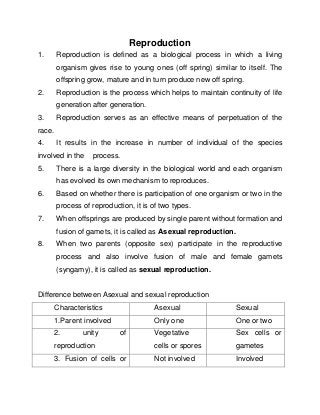
Reproduction Notes for MH-CET
- 1. Reproduction 1. Reproduction is defined as a biological process in which a living organism gives rise to young ones (off spring) similar to itself. The offspring grow, mature and in turn produce new off spring. 2. Reproduction is the process which helps to maintain continuity of life generation after generation. 3. Reproduction serves as an effective means of perpetuation of the race. 4. It results in the increase in number of individual of the species involved in the process. 5. There is a large diversity in the biological world and each organism has evolved its own mechanism to reproduces. 6. Based on whether there is participation of one organism or two in the process of reproduction, it is of two types. 7. When offsprings are produced by single parent without formation and fusion of gamets, it is called as Asexual reproduction. 8. When two parents (opposite sex) participate in the reproductive process and also involve fusion of male and female gamets (syngamy), it is called as sexual reproduction. Difference between Asexual and sexual reproduction Characteristics Asexual Sexual 1.Parent involved Only one One or two 2. unity of reproduction Vegetative cells or spores Sex cells or gametes 3. Fusion of cells or Not involved Involved
- 2. gametes 4.off springs All off springs have same genetic makeup as the parent Off spring show variations due to recombination of genetic characters. 5. Role in life cycle Rapid multiplication in number and perpetuation of same generation ( haploid or diploid ) Results in change of generation form haploid to diploid 6. Mei mitosis Not necessary Always necessary 7. Sign significance Useful in maintaining purity of crop characters Useful in plant breeding and crop improvement.
- 3. Asexual Reproduction: - In this method, a single individual (parent) is capable of producing offspring. As a result, the offspring that are produced are not only identical to one another but are also exact copies of their parent. The term ‘lone’ is used to describe such morphologically and genetically similar individual. ∙ Asexual reproduction is common among single celled organism and in plants and animals with relatively simple structures. Following are the modes of asexual reproduction in different organisms. 1. Binary fission 2. Many single celled organisms reproduce by binary fission, where a cell divides into two halves and each rapidly grows into an adult. 3. Here, the parent cell is replaced by two daughter cells. 4. The single DNA Molecule first replicates, then attaches each copy to a different part of the cell membrane. When the cell begins to pull apart, the replicated DNAs are separated along with the cytoplasm into two daughter cells. 5. Such type of reproduction is seen in 6. Examples of organisms reproducing by this mean are Protists and Monerans such as Amoeba, Paramecium, Bacteria etc.
- 4. Keep on visiting www.ednexa.com for more study material about MH-CET. Feel free to call on our support no. 9011031155/9011041155. - Team Ednexa
